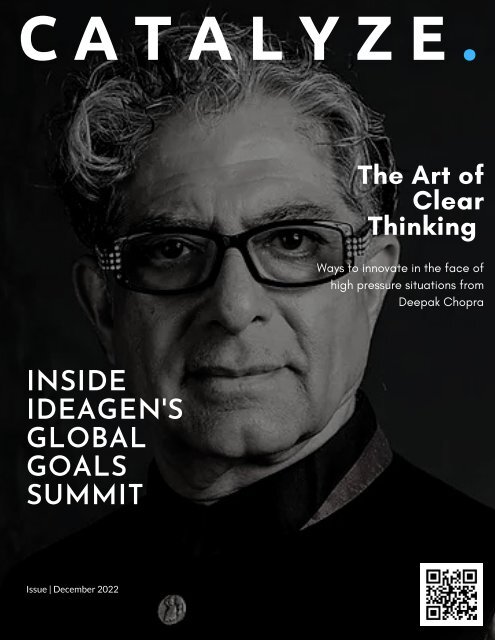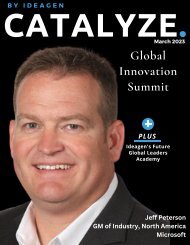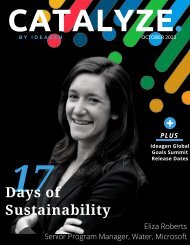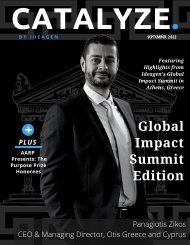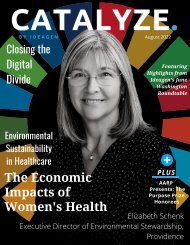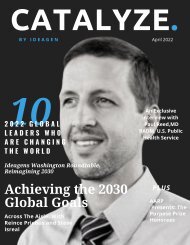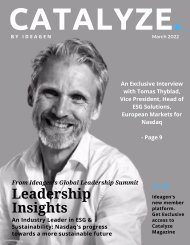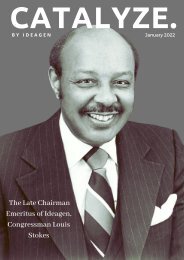Catalyze December
You also want an ePaper? Increase the reach of your titles
YUMPU automatically turns print PDFs into web optimized ePapers that Google loves.
C A T A L Y Z E .
The Art of
Clear
Thinking
Ways to innovate in the face of
high pressure situations from
Deepak Chopra
INSIDE
IDEAGEN'S
GLOBAL
GOALS
SUMMIT
Issue | December 2022
C A T A L Y Z E .
The Art of
Clear
Thinking
Ways to innovate in the face of
high pressure situations from
Deepak Chopra
INSIDE
IDEAGEN'S
GLOBAL
GOALS
SUMMIT
Issue | December 2022
C A T A L Y Z E .
The Art of
Clear
Thinking
Ways to innovate in the face of
high pressure situations from
Deepak Chopra
INSIDE
IDEAGEN'S
GLOBAL
GOALS
SUMMIT
Issue | December 2022
C A T A L Y Z E .
The Art of
Clear
Thinking
Ways to innovate in the face of
high pressure situations from
Deepak Chopra
INSIDE
IDEAGEN'S
GLOBAL
GOALS
SUMMIT
Issue | December 2022
Index
Table of
Contents
Section 1
Deepak Chopra and
Robert Reiss discuss
the status of the
world today and how
each of us can be a
solution to modernday
problems
Section 2
Featured Speakers Include...
Making Mental Health
Mainstream, Featured
interview with Rawle
Andrews Jr:
Section 3
Gretchen O’Hara and the
Great Data Divide
Section 4
Sanjay Rishi and the
Workplace of the Future
Section 5
Grace Clack and an
optimistic outlook on
current climate progress
About The Global
Goals Summit
Live From the UN ECOSOC
Chamber
Ideagen has the unique capacity and privilege to
bring together leaders from a variety of
companies, organizations, and NGOs, The Global
Goals Summit is a forum for executive-level
leaders to discuss the impacts of The Global Goals
on their business and provide solutions to one or
more of the Global Goals.
The Summit's agenda covers topics such as
philanthropy and the public sector, financing for
the SDGs, gender equality, the connection
between health and technology, and more.
Read articles and excerpts from some of the
world's most impactful global leaders speaking at
Ideagen's most anticipated summit to date.
Page 02
Deepak Chopra
Section 1
Section 1
Section 1
The Art of Clear
Thinking
Deepak Chopra's
S-T-O-P Method of
Thinking
Robert Reiss:
What are the first steps for someone who
maybe has a hard time relaxing,
meditating and thinking clearly? And
maybe everyone reading this right now at
home or, anywhere, really, can try your
suggestion.
Deepak Chopra:
They can use what I call the STOP formula,
S-T-O-P. So, before reacting to any
situation or any stressful circumstance
you simply stop.
S stands for smiling from your head to
your toes. This stimulates the vagus
nerve, which is the healing nerve in your
body. Lots of evidence shows that smiling
changes your biology, especially if you
imagine smiling from your head to your
toes
Literally let everything smile. Your nose,
your lips, your tongue, your ears, your
neck, your heart, your fingernails, even
your genitalia. Everything is smiling.
Next is T- take 3 three deep breaths and
keep that smile. Let your body slide into a
deeper state of relaxation with each
exhale. O- Observe your body and it’s
sensations. Observe the environment
without judgment. Then P- proceed with a
decision with awareness and compassion.
S-T-O-P.
Section 2
THE GREAT
DATA DIVIDE
B y G r e t c h e n O ' H a r a
Technology continues to grow and we
all know it moves in leaps and bounds.
Technology is emerging as this new
currency that's driving insight, decisionmaking,
and ultimately knowledge. So
today, as a result, data is now being
produced, consumed, and stored at
dizzying rates. The world has witnessed
the explosion of tenfold growth in data
by Zettabytes since 2013, and we will
see that doubling by 2025. What does
that mean to all of us? Organizations
now are mining. They're collecting,
storing, and securing more data to take
advantage of what essentially now is
this new digital currency, this new gold.
However, while these mountains of data
are being leveraged at breakneck speed
and keeping pace with the growth,
they're really not being leveraged yet
for the benefit of everybody. That is
where you the reader comes in.
There is a growing disparity and the
expanding use of data to create
commercial value and the
comparatively weak use of data to solve
social and environmental challenges.
This data divide is something that I
believe is absolutely separating us and
we have an opportunity and an
obligation together to really change
that. The haves include people and
companies, organizations with plenty of
fresh data that they have that they can
use with the skills that they've been able
to acquire to grow and thrive. While the
have-nots are those that are operating
with a limited sense of data and have no
ability or the skills to be effective with
that data. And what ultimately happens
is that stunts the economic growth and
social advancement as a result of this
data divide.
"This data divide is something that I believe
is absolutely separating us, and we have an
opportunity and an obligation together to
really change that."
This is a crisis that we have to all
come together on. Now, collective
progress continues to be lagging and
it's broadening the chasm as we
speak because of the rate of change
in the massive data that we're
growing.
While these data strategies have
certainly benefited commercial
companies, public sector nonprofits
lag in the education, the skills of the
future workforce, the tools, and the
talent to even access that
information. That means individuals
in underserved communities in most
cases aren't even at the starting line
of what will be the new world of a
data-driven world.
So, what do we have to do about
that? Let me just put a stark reality
of an example in front of us. We can
just look at Covid 19 as a great
example of the crisis of the data
divide. If you can remember back to
the very beginning of the first few
weeks and months of the Covid
Pandemic, there was covid testing
work that was being done across the
globe. But in particular, one
example was a Biohub group
initiative with the University of San
Francisco, California.
This bio hub built covid testing lab
and capabilities in seven days.
Meaning, they were able to not only
get this lab up and running in seven
days they were able to produce lab
results within 24 hours. Think about
this, not knowing anything within
really the first weeks of the
pandemic, but what happened with
data was that they made this
available for all of California to use,
free for the public health system.
The public health system became
so overwhelmed they were even
using fax machines to keep up
with the amount of information
that was coming back from the
data provided. Can you imagine
all of this data available in seven
days promising 24-hour results?
If we had more access to data like
this in the hands of everyone, we
could have kept up and paced
with the speed at which the
pandemic was taking hold
To learn more
MAKING MENTAL HEALTH
MAINSTREAM
As the largest psychiatric organization in the world,
how do you utilize partnerships to achieve absolutely
vital and critical global missions?
Section 3
I always say there are three
C’s that actually go into how
we work with partnerships. One
is competency, the other is
collaboration and the last is
capacity. So, one of the things
that we have learned over 30
plus years of working as part of
the APA (American
Psychological Association) is
that the APA Foundation does
well as a convener, and it does
very well as a thought leader.
VOLUME II
The APA also does great work
in philanthropy, but we cannot
do it alone because there's just
too much work to be done. And
so what we try to do is find
multidisciplinary partners so
that we can cover as many of
the facets of communities as
we can. We work with faith
leaders, we work with teachers,
and educators. We work with
B2B business managers and
owners because they want to
get more for their mission and
out of their team. Sadly,
sometimes they don't have a
mental health partner. And the
fact that we bring medical
professionals to the table is
huge
I.E in one of the many
communities we assist you're
not just going to WebMD trying
to figure this out for yourself.
We give you a true md right?
Right. We can help you work
out whatever problem it is. And
this is just a broad
generalization of what we do in
our partnerships. To give you a
better idea of this; one of the
things that we do is we host (in
the APA foundation) a group
called
the Center for Workplace
Mental Health. The Center for
Workplace Mental Health is all
about the idea of getting more
out of business by treating
managers' mental health. This
gives managers better focus so
that you don't have, in turn,
staff feeling neglected, or
overwhelmed and overworked
because the manager is taken
care of. And if the managers
are happy, you have a happier
employment contingent. Then
they're going to want to do
more for customers, clients,
and so forth.
Figure 1
Rawle Andrews Jr: was
featured at the Global Goals
Summit on Behalf of the
American Psychiatric
Associatioon
PROGRESS
IN CLIMATE
PLEDGES
Section 4
There are 3,470 companies across the globe
that have made climate pledges. Those
companies add up to 80% of the world's GDP.
So you can imagine the impact that those
companies collectively have on global
emissions and what the impact could be if they
all reach net zero. The pressure is coming from
all sides for these companies. Many of our
investment funds today are putting financial
pressure on companies that haven't made
these pledges. 73% of investors say that efforts
to improve the environment and society
actually do impact their financial decisions.
Next, I want to talk about the impact quotient,
That's a great example. of how customers
today are voting with their values. 77% of
customers say that they're motivated to
purchase from companies that are trying to do
good in this world.
It is worth mentioning regulators are also
starting to tighten controls and reporting.
Basically meaning that mandated reporting on
sustainability issues is becoming more
coommon
And then last employees, employees want to
work for companies that are doing good. 93%
of employees say companies should lead with
purpose. At Microsoft, we have 8,000
employees in our sustainability community
alone.
SUSTAINABLE
Future
WORKPLACES
Section 5
By: Dr. Sanjay Rishi
I'm fortunate to be here to share
some ideas on a topic that I'm very
passionate about, and that passion
will come out, so you might have to
excuse me. The workplace has really
changed. If you think about what the
pandemic did with all the devastation
that it caused, we're a resilient
species and we have emerged from
the pandemic. It’s with that, that the
shadows of the pandemic and the
opportunities that are emerging from
the pandemic, and the lessons
learned will really impact how we
think about work, workplace
workspaces, and workers.
There are fundamental significant
tectonic shifts that are happening in
each one of those, some of the things
that I'll touch on and more details
around is as the shift, the idea of
hybrid the idea of technology, and
sustainability responsibility. One of
the things we did with Joint Indication
Indicators (Jll) about two years ago,
as we said in our purpose statement,
we put in a better world and we said
we want our domain and our
responsibility to create a better world.
Well, that better world has many
implications. It's around many of the
things we address in this magazine
like mental health, physical health,
sustainability, diversity, equity, and
inclusion.
The way I group them around
works that is; personalized
work, which is responsible, and
workspaces that are
responsible Well, let's go
exactly into those. When you
talk about something like
sustainability, there's an
enormous impact on everything
you're doing in the workplace.
From a sustainability
standpoint,
I'll start with the example of the
leaps and bounds we've come
at Davos in 2020, in February
just before the pandemic hit.
There, you could see CEOs
across the globe all making
commitments around net zero
carbon neutrality. One of the
things that we're seeing is
while those commitments were
made, the question that I
always ask when I'm with C
suites and colleagues is- let's
test and make sure that the
road maps are implemented,
that there are details around it
that are getting the attention
because there's so much going
One of the things that we're seeing
is while those commitments were
made, the question that I always
ask when I'm with C suites and
colleagues is- let's test and make
sure that the road maps are
implemented, that there are details
around it that are getting the
attention because there's so much
going on. There are
macroeconomic headwinds, that
are clearly impacting us.
A little statistics for the audience,
40% of the planet's carbon
emissions come from built
environments. We live in them, we
work in them, we shop in them, we
travel to airports, 40% comes from
that, that's our business, that's my
business to influence that. So, if
we can influence it in partnership
with everyone, this is no longer a
debate. This is something that has
to be done. And more importantly,
the commitment to sustainability is
real. It's happening across the
globe. So, we're on a good path
but we need partnerships like
these to bring down that 40%
statistic.
on. 6
1
D E E P A K C H O P R A
G R E T C H E N O ' H A R A
2
3
B A R B Q U A I N T A N C E
R A W L E A N D R E W S
4
5
G R A C E C L A C K
Section 6
BLUE NILE'S
DIAMOND
NETWORK
WITH BLUE NILE CEO SEAN KELL
Ed Reno
One of the questions that I think is
potentially sensitive, but I just want to
explore is in regards to diamonds in how
you source them. I know there's a strong
push for ethics in that process, and
maybe you could frame for our audience
what historically have been some of the
concerns and considerations of the
industry, and perhaps how Blue Nile has
tried to responsibly come into the
marketplace.
Sean Kell
Great question. So, for over 20 years
now, blue Nile has been very focused on
only sourcing diamonds in a sustainable
conflict-free way. All of our diamonds are
certified to be conflict free, which is a
very specific set of processes and
certifications to get there.
Also increasingly there are sustainability
requirements with different origin
countries. Most diamonds come from
Africa, Australia, and Canada, and that's
where we source our diamonds from.
The diamond's origin governments have
put tremendous amounts of work into
making sure that everything is ethically
sourced and sustainably sourced.
Because in many places, this is the
primary GDP-driving product for the
region.
Sean Kell
Oftentimes, diamonds provide a
tremendous amount of resources for the
population of these source and origin
countries. So there's been a big push
over the last 20, 30, and 40 years to
make sure that all gem-quality diamonds
are sourced sustainably and ethically in a
conflict-free way.
Ed Reno
Right, so that's interesting to me in that
Blue Nile does not have anyone with a
pickax or a light on their head deep in a
cave. Your partner is the regional
authorities' government. Is that right?
Sean Kell
We are a couple of steps from them, but yes. The diamond supply chain is a long and complicated one,
and frankly, it's been this way for over a hundred years. So there's a mine in an origin country, generally
owned by the government of that country. And they're contracting with a mining company like De
Beers, who will help them source the diamonds in a sustainable and conflict-free ethical way. Then
those diamonds are shipped to a central location, those are rough diamonds. It looks kind of like a piece
of, scrap glass. Those pieces of rough diamond are then shipped to a central processing facility where
people, and it's almost all done by hand, people will cut. That's right. Cut and polish those rough dull
looking cloudy looking pieces of carbon into what we know as sparkly, gorgeous diamonds with
different cuts and facets depending on the size and shape of the diamond. That is done typically in
Belgium, Israel, and India. Then the diamonds kind of move their way through the supply chain, through
distributors to secondary distributors, to third-tier distributors, and then ultimately to people like us,
retailers.
IDEAGEN TV PRESENTS
AUTHENTIC LEADERSHIP
WITH ED RENO
Ed Reno
Sean Kell
CEO
Blue Nile
Diamonds
Exclusively on IdeagenGlobal.com
Editor's Note
Dear Ideagen Global Friends and Colleagues,
As we prepare for the September 8th release of the Ideagen Global
Impact Summit and 17 Days of Sustainability in October, Ideagen
Global continues to maximize our efforts with a relentless commitment
to convene the world's greatest minds from the world's leading
companies, NGOs, and the public sector to address the world's most
vexing issues. In 2022, Ideagen TV content will again reach over 100
Million People across the planet with our ubiquitous content
distribution, including inspiring interviews and custom programming to
create awareness and Global Partnerships to Achieve the Goals.
2022 is already an #EPIC year with high-impact hybrid/live events
across the planet, including Athens, Greece, New York, and many other
global destinations! Join the movement at IdeagenGlobal.com for all of
the latest updates.
Sincerely,
GEORGE SIFAKIS
GEORGE SIFAKIS
Editor-in-Chief & CEO
Ideagen
CATALYZE MAGAZINE | 24
COOPER HENDERSON
Lead Publication Editor
DANIEL KERNS
Co-Editor and Chief of Staff
Pictured Top to Bottom
Microsoft's Tilemachos Moraitis
ACS Athens's Peggy Pelonis
Amb. Angelos Pangratis (ret.)
Top Left: Ideagen's Global Impact Summit
